
Liverpool is a city and metropolitan borough in Merseyside, northwest England. It had a population of 486,100 in 2021. The city is located on the eastern side of the Mersey Estuary, adjacent to the Irish Sea, and is approximately 178 miles (286 km) from London. The wider Liverpool built-up area is the third-largest in England and Wales outside London. Liverpool itself is the largest settlement in the Liverpool City Region, which is the fourth-largest combined authority in the UK with a population of over 1.5 million in 2021. The city also forms part of a larger urban region of over 2 million people which extends into the neighbouring counties of Cheshire and Lancashire, as well as northeast Wales. The region shares political boundaries and significant economic connections.

In the United Kingdom, a listed building is a structure of particular architectural and/or historic interest deserving of special protection. Such buildings are placed on one of the four statutory lists maintained by Historic England in England, Historic Environment Scotland in Scotland, Cadw in Wales, and the Northern Ireland Environment Agency in Northern Ireland. The classification schemes differ between England and Wales, Scotland, and Northern Ireland. The term has also been used in the Republic of Ireland, where buildings are protected under the Planning and Development Act 2000, although the statutory term in Ireland is "protected structure".

West Derby is a suburb of Liverpool, England. It is located east of the city and is also a Liverpool City Council ward. At the 2011 Census, the population was 14,382.
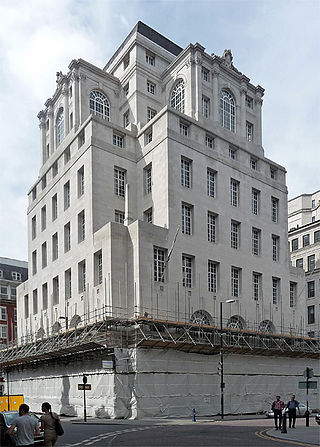
100 King Street, formerly the Midland Bank, is a former bank premises on King Street in Manchester, England. It was designed by Sir Edwin Lutyens in 1928 and constructed in 1933–35. It is Lutyens' major work in Manchester and was designated a Grade II* listed building in 1974.
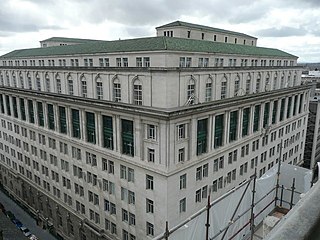
India Buildings is a commercial building with its principal entrance in Water Street, Liverpool, England. Mainly an office building, it also contained an internal shopping arcade and the entrance to an underground station. It was built between 1924 and 1932, damaged by a bomb in 1941, and later restored to its original condition under the supervision of one of its original architects. The building, its design influenced by the Italian Renaissance and incorporating features of the American Beaux-Arts style, occupies an entire block in the city.

Palace Green is an area of grass in the centre of Durham, England, flanked by Durham Cathedral and Durham Castle. The Cathedral and Castle together form a UNESCO World Heritage Site.

The Bank of England Building is a Grade I listed building located in Liverpool, England.
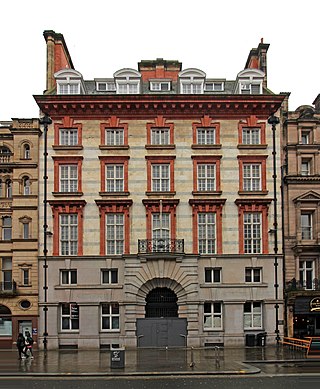
The National Westminster Bank, Castle Street, Liverpool, England is a Grade II* listed building.

Lime Street in Liverpool, England, was created as a street in 1790. Its most famous feature is Lime Street railway station. It is part of the William Brown Street conservation area.

62 Castle Street is a Grade II listed building located on the west side of Castle Street, Liverpool. It was built in 1868 for the Alliance Bank and was later occupied by The North and South Wales Bank and most recently by the Midland Bank. The building was designed by the architects Lucy and Littler and features a domed banking hall with paired corinthian columns. The two bays to the right of the building are a matching addition, designed by G. E. Grayson.

The architecture of Manchester demonstrates a rich variety of architectural styles. The city is a product of the Industrial Revolution and is known as the first modern, industrial city. Manchester is noted for its warehouses, railway viaducts, cotton mills and canals – remnants of its past when the city produced and traded goods. Manchester has minimal Georgian or medieval architecture to speak of and consequently has a vast array of 19th and early 20th-century architecture styles; examples include Palazzo, Neo-Gothic, Venetian Gothic, Edwardian baroque, Art Nouveau, Art Deco and the Neo-Classical.
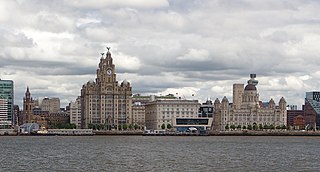
Liverpool Maritime Mercantile City is a former UNESCO designated World Heritage Site in Liverpool, England, that comprised six locations in the city centre including the Pier Head, Albert Dock and William Brown Street, and many of the city's most famous landmarks.
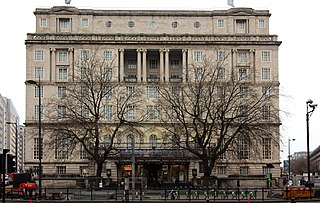
The Britannia Adelphi Hotel is in Ranelagh Place, Liverpool city centre, Merseyside, England. The present building is the third hotel on the site, and is recorded in the National Heritage List for England as a designated Grade II listed building. The building is owned and managed by Britannia Hotels. It contains 402 en-suite bedrooms, conference and dining facilities, and a gymnasium.

The architecture of Liverpool is rooted in the city's development into a major port of the British Empire. It encompasses a variety of architectural styles of the past 300 years, while next to nothing remains of its medieval structures which would have dated back as far as the 13th century. Erected 1716–18, Bluecoat Chambers is supposed to be the oldest surviving building in central Liverpool.

The Prudential Assurance Building is a Grade II listed, Victorian Gothic revival style office building located on Dale Street in the centre of Liverpool, England.

Liverpool is a city and port in Merseyside, England, which contains many listed buildings. A listed building is a structure designated by English Heritage of being of architectural and/or of historical importance and, as such, is included in the National Heritage List for England. There are three grades of listing, according to the degree of importance of the structure. Grade I includes those buildings that are of "exceptional interest, sometimes considered to be internationally important"; the buildings in Grade II* are "particularly important buildings of more than special interest"; and those in Grade II are "nationally important and of special interest". Very few buildings are included in Grade I — only 2.5% of the total. Grade II* buildings represent 5.5% of the total, while the great majority, 92%, are included in Grade II.
There are over 2500 listed buildings in Liverpool, England. A listed building is one considered to be of special architectural, historical or cultural significance, which is protected from being demolished, extended or altered, unless special permission is granted by the relevant planning authorities. Of the listed buildings in Liverpool, 105 are classified as Grade II* listed and are recognised as being particularly important with more than special architectural or historic interest. Of these, 46 are located within the L1, L2 and L3 postcodes, which cover the city centre of Liverpool. The following list provides information on all the Grade II* listed buildings within these postcodes.
There are over 9,000 Grade I listed buildings in England. This page is a list of these buildings in the unitary authority of Cheshire East.






















